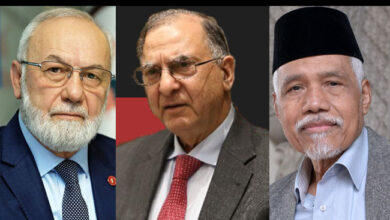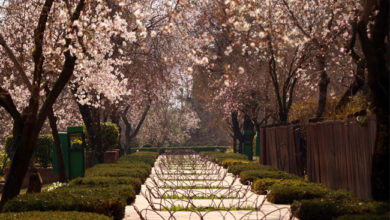World News
China Is Exporting Its Anti-Muslim Strategy to India

Muslims in Kashmir may find themselves in a Xinjiang-style dystopia thanks to Chinese technology and Narendra Modi’s Hindu nationalism.
In July 2009, days after violent riots in Urumqi, the capital of Xinjiang and homeland of the mostly Muslim Uighurs, Chinese authorities took the drastic move of shutting down the Internet and all other communications. For 10 months, the entire region—larger than Texas and home to more than 20 million residents—was cut off from the world.
A decade later, just across the border, Indian authorities cut Internet, mobile, and even postal communication in Muslim-majority Kashmir as they stripped the state of its special autonomy. Despite their allowing, on October 14, a limited number of mobile phones to function, Kashmir for the most part remains isolated to this day, and no one knows when communication will be restored.
“The current Kashmir shutdown, and in particular the turning off of the Internet and communications, is awfully similar to the one in Xinjiang post-2009 riots,” James Millward, a professor at Georgetown University and an expert in Central Asian history, said. “One wonders if [Prime Minister Narendra] Modi is taking a page from the Chinese book there.”
In fact, Kashmir and Xinjiang, which are separated by the Himalayas, share many worrying similarities. The 2009 Xinjiang shutdown was just the start of a series of horrors for Uighurs. Under the guise of anti-terrorism after a series of attacks and, notably, a 2008 incident that killed dozens Chinese policeman in Kashgar, the space for Uighurs’ expression and freedom has gradually shrunk, as all aspects of their cultural, social, and religious lives have come under the control of Chinese authorities.
Today, the region is host to a techno-digital dystopia, with massive surveillance policing nearly every aspect of Uighur lives. Since 2017, the repression has taken an even darker turn, with the building of massive concentration camps hosting upward of 1.5 million Uighurs, few of whom have been charged with any crime.
“Kashmir and Xinijang have many parallels,” Ovais Sultan Khan, a human rights activist and director of Future Council, a Delhi-based think tank, said. “Uighur Muslims are facing genocide by the Chinese state, and both India and China are using their own tactics to oppress Uighur and Kashmiri people.”
It was unfortunate quirks of colonialism and history that led each Muslim majority region to become an unwilling part of a larger neighbor. Kashmir became part of India in 1947 in a move that remains contested, while Xinjiang became part of the newly founded People’s Republic of China in 1949, after a military invasion that ended a short-lived independent Turkic Muslim state. Neither have had referendums or any form of self-determination, making them de facto modern colonies.
“They are both Muslim-majority places that have, through the processes of the 20th century, ended up in non–Muslim majority countries, and that identity has been a source of some of the problems,” Millward said.
Not surprisingly, over the past decades, both regions have seen waves of militarism, conflict, and repression. More recently, though, it is the rise of global ethno-nationalism, a phenomenon seen in the West too, that is driving more fierce state-led oppression.
“There is a broader, global parallel to what’s happening in Xinjiang and Kashmir, the global nativist trend,” Millward said, pointing to the rapid rise of Hindu nationalism in India and the shift, under Xi Jingping, away from multiculturalism and toward a unified singular Chinese identity, meaning forced assimilation for ethnic minorities, especially Muslims.
In fact, Islamophobia and online hate against Muslims has been rising in both countries. India has been seeing rising hate crimes, including the growth of vigilantes and lynch mobs, targeting Muslims across the country. In China, you cannot find discussions about topics like the 1989 Tiananmen massacre, photos of the Dalai Lama, or even photos of Winnie the Pooh because of censorship, but you can find plenty of anti-Muslim content.
Underpinning this identity rhetoric in both regions is an emphasis on national security and counterterrorism. Like in Xinjiang, terrorism has played a role in Kashmir. The current crackdown is linked to the March 2019 attack on a convoy by an Islamist suicide bomber in Pulwana, which killed 40 police personnel.
In Kashmir, surveillance technology, some of it possibly sourced from the very companies enabling Chinese repression in Xinjiang, are creeping in. While the Xinjiang model is still the cutting edge of the digital authoritarian state, Kashmir may not be that far behind. Hikvision, a Chinese state-controlled company and one of the world’s largest developers of sophisticated CCTV surveillance systems, had contracts with Chinese police in Xinjiang, and is now exporting technology to India, according to a recent report from the Carnegie Endowment. Alongside CCTV systems, the use of drones and other aerial vehicles to monitor mosques and the movement of Kashmiris has become pervasive, and there’s even a “smart border” that resembles Chinese efforts to limit the movement of people along the Xinjiang and Tibet borders. Limited access to Indian police and military procurement documents means it is difficult to directly connect Chinese surveillance giants to Kashmir. The shutdown only makes this harder.
“In Kashmir…we don’t know all the technology and what they’re deploying there,” Raman Jit Singh Chima, Asia policy director at Access Now, said.
Beyond the shutdown and the growing surveillance network, there is also worrying rhetoric from Modi’s far-right Hindu nationalist government. There is talk about moving Hindu migrants to Kashmir and allowing Indian and foreign businesses to exploit the resource-rich region, enabled by the removal of laws that forbid non-Kashmiris from owning land in Kashmir. This echoes what has happened in Xinjiang. Encouraged by state policies in the 1950s and ’60s, and by economic opportunities in more recent years, Han Chinese now nearly equal the Uighur population in the region, and vastly outnumber them in the capital, Urumqi. Chinese businesses have invested billions in exploiting natural resources.
There is even chatter on Indian social media about Hindu men marrying fair-skinned Kashmiri women—mimicking the increasing number of stories about forced marriages between Han Chinese men and Uighur women in Xinjiang.
For now, the best hope for Kashmir lies in the fact that India has not yet gone as far down the authoritarian path as China. There remains a civil society, albeit one under increasing pressure, some free press, and a supposedly independent judicial system; there are several cases going through various stages of the court system that seek to force the government to end the shutdown, and respect Kashmiri human rights. But none of them will come to fruition overnight, and some worry that the courts are slowing things down deliberately, perhaps because of pressure from the Modi government.
“Just a few years ago, the Indian Supreme Court said that India’s fundamental right to free speech applies online, and any government restrictions had to pass strict constitutional tests,” Chima said. “The fact that the courts have been slow in providing relief on this have is extremely concerning.”
If India’s courts do not limit the Modi government’s use of national security to cut off an entire region, it could embolden them to further implement draconian, tech-driven surveillance to repress Kashmiris and cement Indian control over the region. Then, other parts of India, which has the second-largest Muslim population in the world, could follow.
“The bigger danger is that this new normal in Kashmir becomes the new normal for the rest of the Indian republic as well, the idea that if you believe you have a national security justification, you can do anything you want,” Chima added.
As China’s other ethnic minorities, such as the Hui, Tibetans, Kazakhs, and even Hongkongers are seeing, repression and authoritarian technology does not stay in once part of a country, or even region. Rather, it expands and spreads. Ten years ago, it was Xinjiang. Today, it’s Kashmir. Tomorrow, it could be whatever remains of India’s democracy.





